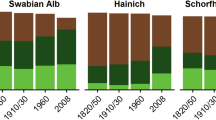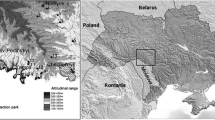Abstract
Context
It is known that land-use and land-cover (LULC) changes affect plant community assembly for decades. However, both the short- and the long-term effects of contrasting LULC change pathways on this assembly are seldom explored.
Objectives
To assess how LULC change pathways affect woody plant community parameters (i.e. species richness, diversity and evenness) and species’ presence and abundance, compared with environmental factors and neutral processes.
Methods
The study was performed in Mediterranean limestone scrublands in NE Spain. Cover of each woody species was recorded in 150 scrubland plots belonging to five LULC change pathways along the past century, identified using land-cover maps and fieldwork. For each plot, total woody and herbaceous vegetation cover, local environmental variables and geographical position were recorded. Effects of these pathways and factors on plant community parameters and on species presence and abundance were assessed, considering spatial effects potentially associated to neutral processes.
Results
Species richness and diversity were associated with LULC change pathways and elevation, while evenness was only associated with this last. Pathways and environmental variables explained similar variance in both species’ presence and cover. In general, while community parameters were affected by recent-past (1956) use, species presence and abundance were associated with far-past (pre-1900) cropping. No relevant spatial effect was detected for any studied factor.
Conclusions
Historical LULC changes and current environmental factors drive local-scale community assembly in Mediterranean scrublands to an equal extent, while contrasting time-scale effects are found at community and species level. Neutral, dispersal-based processes are found to be non-relevant.



Similar content being viewed by others
References
Aiello-Lammens ME, Slingsby JA, Merow C, Mollmann HK, Euston-Brown D, Jones CS, Silander JA Jr (2017) Processes of community assembly in an environmentally heterogeneous, high biodiversity region. Ecography 40:561–576
Badia-Miró M, Garrabou R, Tello E, Valls F (2010) The Grape Phylloxera plague as a natural experiment: explaining the long-term development and upkeep of vineyard specialization in Catalonia (Spain, 1860–1935). Aust Econ Hist Rev 50:39–60
Bagaria G, Helm A, Rodà F, Pino J (2015) Assessing coexisting plant extinction debt and colonization credit in a grassland–forest change gradient. Oecologia 79:823–834
Basnou C, Álvarez E, Bagaria G, Guardiola M, Isern R, Vicente P, Pino J (2013) Spatial patterns of land use changes across a Mediterranean metropolitan landscape: implications for biodiversity management. Environ Manage 52:971–980
Basnou C, Vicente P, Espelta JM, Pino J (2016) Of niche differentiation, dispersal ability and historical legacies: what drives woody community assembly in recent Mediterranean forests? Oikos 125:107–116
Batriu E, Pino J, Rovira P, Ninot JM (2011) Environmental control of plant species abundance in a microtidal Mediterranean saltmarsh. Appl Veg Sci 14:358–366
Bolòs O, Vigo J, Masalles RM, Ninot JM (2005) Flora manual dels Països Catalans. Pòrtic, Barcelona
Bonet A, Pausas JG (2004) Species richness and cover along a 60-year chronosequence in old-fields of southeastern Spain. Plant Ecol 174:257–270
Bürgi M, Oëstlund L, Mladenoff D (2017) Legacy effects of human land use: ecosystems as time-lagged systems. Ecosystems 20:94–103
Cousins S, Vanhoenacker D (2011) Detection of extinction debt depends on scale and specialisation. Biol Conserv 144:782–787
Cristofoli S, Piqueray J, Dufrene M, Bizoux JP, Mahy G (2010) Colonization credit in restored wet heathlands. Restor Ecol 18:645–655
Dambrine E, Dupouey JL, Laüt L, Humbert L, Thinon M, Beaufils T, Richard H (2007) Present forest biodiversity patterns in France related to former Roman agriculture. Ecology 88:1430–1439
Debussche M, Lepart J, Dervieux A (1999) Mediterranean landscape changes: evidence from old postcards. Glob Ecol Biogeogr 8:3–15
Di Pasquale G, Di Martino P, Mazzoleni S (2004) Forest history in the Mediterranean region. In: Mazzoleni S, Di Pasquale G, Mulligan M, Di Martino P, Rego F (eds) Recent dynamics of the Mediterranean vegetation and landscape. Wiley, Chichester, pp 13–20
Dupouey JL, Dambrine E, Laffite JD, Moares C (2002) Irreversible impact of past land use on forest soils and biodiversity. Ecology 83:2978–2984
Geary M, Fielding AH, McGowan PJK, Marsden SJ (2015) Scenario-led habitat modelling of land use change impacts on key species. PLoS ONE 10:e0142477
Grove AT, Rackham O (2001) The nature of Mediterranean Europe: an historical ecology. Yale University Press, New Haven
Guirado M, Pino J, Rodà F (2007) Comparing the role of site disturbance and landscape properties on understory species richness in fragmented periurban Mediterranean forests. Landsc Ecol 22:117–129
Hermy M, Verheyen K (2007) Legacies of the past in the present-day forest biodiversity: a review of past land-use effects on forest plant species composition and diversity. Ecol Res 22:361–371
Hubbell SP (2006) Neutral theory and the evolution of ecological equivalence. Ecology 87(6):1387–1398
Huxel GR, Hastings A (1999) Habitat loss, fragmentation, and restoration. Restor Ecol 7:309–315
Jackson ST, Sax DF (2010) Balancing biodiversity in a changing environment: extinction debt, immigration credit and species turnover. Trends Ecol Evol 25:153–160
Jacquemyn H, Butaye J, Hermy M (2003) Influence of environmental and spatial variables on regional distribution of forest plant species in a fragmented and changing landscape. Ecography 26:768–776
Körner C, Stöcklin J, Reuther-Thiébaud L, Pelaez-Riedl S (2008) Small differences in arrival time influence composition and productivity of plant communities. New Phytol 177:698–705
Kuussaari M, Bommarco R, Heikkinen RK, Helm A, Krauss J, Lindborg R, Öckinger E, Pärtel M, Pino J, Rodà F, Stefanescu C, Teder T, Zobel M, Steffan-Dewenter I (2009) Extinction debt: a challenge for biodiversity conservation. Trends Ecol Evol 24:564–571
Leibold MA, Holyoak M, Mouquet M, Amarasekare P, Chase JM, Hoopes MF, Holt RD, Shurin JB, Law R, Tilman D, Loreau M, Gonzalez A (2004) The metacommunity concept: a framework for multi-scale community ecology. Ecol Lett 7:601–613
Leibold MA, McPeek MA (2006) Coexistence of the niche and neutral perspectives in community ecology. Ecology 87:1399–1410
MacArthur RH, Wilson EO (1967) The theory of island biogeography. Princeton University Press, Princeton
Martín-Queller E, Gil-Tena A, Saura S (2011) Species richness of woody plants in the landscapes of Central Spain: the role of management disturbances, environment and non-stationarity. J Veg Sci 22:238–250
Mihaljevic JR (2012) Linking metacommunity theory and symbiont evolutionary ecology. Trends Ecol Evol 27:323–329
Montoya D, Zavala MA, Rodríguez MA, Purves DW (2008) Animal versus wind dispersal and the robustness of tree species to deforestation. Science 320:1502–1504
Motzkin G, Eberhardt R, Hall B, Foster DR, Harrod J, MacDonald D (2002) Vegetation variation across Cape Cod, Massachusetts: environmental and historical determinants. J Biogeogr 29:1439–1454
Motzkin G, Wilson P, Foster DR, Allen A (1999) Vegetation patterns in heterogeneous landscapes: the importance of history and environment. J Veg Sci 10:903–920
Nadal F, Urteaga L, Muro JI (2006) El territori dels geòmetres. Cartografia parcel·lària dels municipis de la província de Barcelona (1845–1895). Institut d’Edicions de la Diputació de Barcelona, Barcelona
Navarro-González I, Pérez-Luque AJ, Bonet FJ, Zamora R (2013) The weight of the past: land-use legacies and recolonization of pine plantations by oak trees. Ecol Appl 23:1267–1276
Nekola JC, White PS (1999) Distance decay of similarity in biogeography and ecology. J Biogeogr 26:867–878
Noble IR, Slatyer RO (1980) The use of vital attributes to predict successional changes in plant communities subject to recurrent disturbances. Vegetatio 43:5–21
Paül V, Serrano D (2003) El paisatge garrafenc del XIX. Aportacions a partir del buidatge dels amillaraments de mitjan segle. In: IV Trobada d’Estudiosos del Garraf. Diputació de Barcelona, Barcelona, pp 201–208
Perring MP, De Frenne P, Baeten L, Maes SL, Depauw L, Blondeel H, Carón MM, Verheyen K (2016) Global environmental change effects on ecosystems: the importance of land-use legacies. Glob Change Biol 22:1361–1371
Piqueray J, Cristofoli S, Bisteau E, Palm R, Mahy G (2011) Testing coexistence of extinction debt and colonization credit in fragmented calcareous grasslands with complex historical dynamics. Landscape Ecol 26:823–836
Puerta-Piñero C, Espelta JM, Sánchez-Humanes B, Rodrigo A, Coll L, Brotons L (2012) History matters: Previous land use changes determine post-fire vegetation recovery in forested Mediterranean landscapes. Forest Ecol Manag 279:121–127
Svenning JC, Baktoft KH, Balslev H (2009) Land-use history affects understorey plant species distributions in a large temperate-forest complex, Denmark. Plant Ecol 201:221–234
Tatoni T, Roche P (1994) Comparison of old-field and forest revegetation dynamics in Provence. J Veg Sci 5:295–302
Tilman D, May RM, Lehman CL, Nowak MA (1994) Habitat destruction and the extinction debt. Nature 371:65–66
Tilman D (2004) Niche tradeoffs, neutrality, and community structure: a stochastic theory of resource competition, invasion, and community assembly. PNAS 101:10854–10861
Vellend M (2004) Parallel effects of land-use history on species diversity and genetic diversity of forest herbs. Ecology 85:3043–3055
Vellend M (2005) Land-use history and plant performance in populations of Trillium grandiflorum. Biol Conserv 124:217–224
Vellend M, Verheyen K, Jacquemyn H, Kolb A, Van Calster H, Peterken G, Hermy M (2006) Extinction debt of forest plants persists for more than a century following habitat fragmentation. Ecology 87:542–548
Verheyen K, Guntenspergen G, Hermy M (2003) An integrated analysis of the effects of past land-use on forest plant species colonization at the landscape scale. J Ecol 91:731–742
Wikum D, Shanholtzer GF (1978) Application of the Braun-Blanquet cover-abundance scale for vegetation analysis in land development studies. Environ Manage 2:323–329
Ziter C, Graves RA, Turner MG (2017) How do land-use legacies affect ecosystem services in United States cultural landscapes? Landscape Ecol 32:2205–2218
Acknowledgements
The study was partially funded by the FORASSEMBLY (CGL2015-70558-P) and NEWFORLAND (RTI2018-099397-B-C22) projects of the Spanish Ministry of Economy and Competitiveness, and by the Fondo de Incentivos of the Consejo Nacional para Investigaciones Científicas y Tecnológicas (CONICIT), Ministerio de Ciencia, Tecnología y Telecomunicaciones (MICITT) of Costa Rica.
Author information
Authors and Affiliations
Corresponding author
Additional information
Publisher's Note
Springer Nature remains neutral with regard to jurisdictional claims in published maps and institutional affiliations.
Electronic supplementary material
Below is the link to the electronic supplementary material.
Rights and permissions
About this article
Cite this article
Gamboa-Badilla, N., Segura, A., Bagaria, G. et al. Contrasting time-scale effects of land-use legacy on species richness, diversity and composition in Mediterranean scrubland communities. Landscape Ecol 35, 2745–2757 (2020). https://doi.org/10.1007/s10980-020-01087-5
Received:
Accepted:
Published:
Issue Date:
DOI: https://doi.org/10.1007/s10980-020-01087-5




